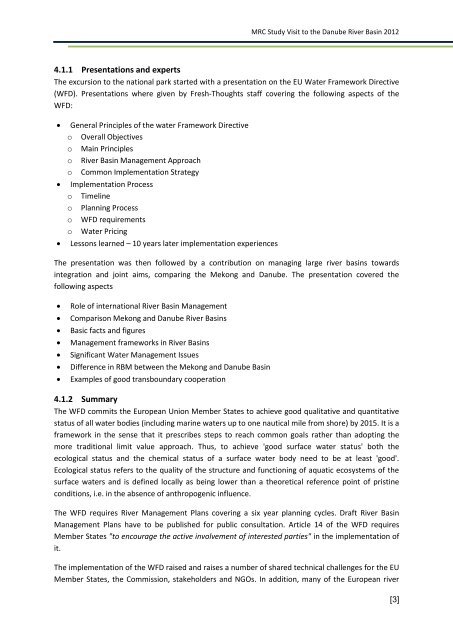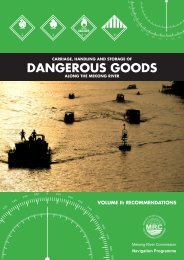evaluation of the study visit - Mekong River Commission
evaluation of the study visit - Mekong River Commission
evaluation of the study visit - Mekong River Commission
You also want an ePaper? Increase the reach of your titles
YUMPU automatically turns print PDFs into web optimized ePapers that Google loves.
MRC Study Visit to <strong>the</strong> Danube <strong>River</strong> Basin 2012<br />
4.1.1 Presentations and experts<br />
The excursion to <strong>the</strong> national park started with a presentation on <strong>the</strong> EU Water Framework Directive<br />
(WFD). Presentations where given by Fresh-Thoughts staff covering <strong>the</strong> following aspects <strong>of</strong> <strong>the</strong><br />
WFD:<br />
� General Principles <strong>of</strong> <strong>the</strong> water Framework Directive<br />
o Overall Objectives<br />
o Main Principles<br />
o <strong>River</strong> Basin Management Approach<br />
o Common Implementation Strategy<br />
� Implementation Process<br />
o Timeline<br />
o Planning Process<br />
o WFD requirements<br />
o Water Pricing<br />
� Lessons learned – 10 years later implementation experiences<br />
The presentation was <strong>the</strong>n followed by a contribution on managing large river basins towards<br />
integration and joint aims, comparing <strong>the</strong> <strong>Mekong</strong> and Danube. The presentation covered <strong>the</strong><br />
following aspects<br />
� Role <strong>of</strong> international <strong>River</strong> Basin Management<br />
� Comparison <strong>Mekong</strong> and Danube <strong>River</strong> Basins<br />
� Basic facts and figures<br />
� Management frameworks in <strong>River</strong> Basins<br />
� Significant Water Management Issues<br />
� Difference in RBM between <strong>the</strong> <strong>Mekong</strong> and Danube Basin<br />
� Examples <strong>of</strong> good transboundary cooperation<br />
4.1.2 Summary<br />
The WFD commits <strong>the</strong> European Union Member States to achieve good qualitative and quantitative<br />
status <strong>of</strong> all water bodies (including marine waters up to one nautical mile from shore) by 2015. It is a<br />
framework in <strong>the</strong> sense that it prescribes steps to reach common goals ra<strong>the</strong>r than adopting <strong>the</strong><br />
more traditional limit value approach. Thus, to achieve 'good surface water status' both <strong>the</strong><br />
ecological status and <strong>the</strong> chemical status <strong>of</strong> a surface water body need to be at least 'good'.<br />
Ecological status refers to <strong>the</strong> quality <strong>of</strong> <strong>the</strong> structure and functioning <strong>of</strong> aquatic ecosystems <strong>of</strong> <strong>the</strong><br />
surface waters and is defined locally as being lower than a <strong>the</strong>oretical reference point <strong>of</strong> pristine<br />
conditions, i.e. in <strong>the</strong> absence <strong>of</strong> anthropogenic influence.<br />
The WFD requires <strong>River</strong> Management Plans covering a six year planning cycles. Draft <strong>River</strong> Basin<br />
Management Plans have to be published for public consultation. Article 14 <strong>of</strong> <strong>the</strong> WFD requires<br />
Member States "to encourage <strong>the</strong> active involvement <strong>of</strong> interested parties" in <strong>the</strong> implementation <strong>of</strong><br />
it.<br />
The implementation <strong>of</strong> <strong>the</strong> WFD raised and raises a number <strong>of</strong> shared technical challenges for <strong>the</strong> EU<br />
Member States, <strong>the</strong> <strong>Commission</strong>, stakeholders and NGOs. In addition, many <strong>of</strong> <strong>the</strong> European river<br />
[3]













